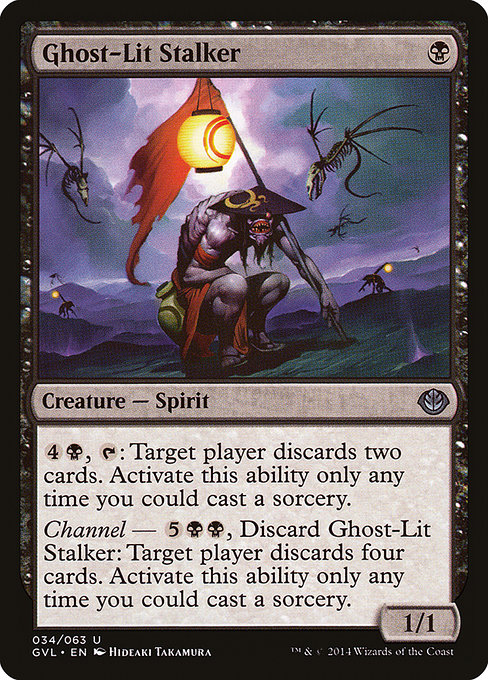
Image courtesy of Scryfall.com
Ghost-Lit Stalker and the Channel keyword: A quick comparison
In the dim corners of black mana strategy, Ghost-Lit Stalker offers a tiny but fierce lesson in how a single creature can double as a toolbox for disruption. This 1/1 Spirit from the Duel Decks Anthology: Garruk vs. Liliana is a micro-tutorial in cost, timing, and the elegance of hot-swappable effects. Its two discard-focused abilities show a contrast that MTG players love: one traditional, one radical and “channel-ed.” 🧙♂️🔥
At a glance
- Name: Ghost-Lit Stalker
- Mana Cost: {B}
- Type: Creature — Spirit
- Power/Toughness: 1/1
- Colors / Color Identity: Black
- Rarity: Uncommon
- Set: Duel Decks Anthology: Garruk vs. Liliana (GVL)
- Oracle text:
{4}{B}, {T}: Target player discards two cards. Activate only as a sorcery.
Channel — {5}{B}{B}, Discard this card: Target player discards four cards. Activate only as a sorcery.
The two paths to disruption
The card presents two distinct modes to pressure an opponent’s hand. The first is straightforward and playable from the battlefield: pay 4 neutral mana (plus the black mana) and tap down the Stalker to coax two cards away from your opponent’s grip. It’s a classic, reliable hand-attack option that scales with the rest of your deck’s discard strategies. The cost is steep enough that you’ll usually deploy it in spots where you can protect the Stalker or where the information about your opponent’s hand justifies the tempo hit. This ability reminds us that even a lowly 1/1 creature can become a decisive engine when paired with the right game plan. ⚔️
The second option is more esoteric, but deeply flavorful and potent in the right context: Channel — {5}{B}{B}, discard this card to force four cards from your opponent’s hand to go away. The channel mechanic is a clever design choice that asks you to invest from hand rather than from the battlefield. It’s a one-shot, high-run disruption that feels ancient and eerie—the way a specter could barge into a game from the shadows. The requirement that this be activated only as a sorcery adds a scheduling challenge; you can’t do it on a whim, you must plan your turns, and you must tempo-control the moment you reveal the ghost. The effect itself—four cards discarded in one shot—packs a wallop that can swing mid-to-late game states in older formats and in Commander tables where hand disruption remains a respected lever. 🧙♂️
When to cast which, and why it matters
Timing is everything with Ghost-Lit Stalker. In a vacuum, the 4B ability is the bread-and-butter churn: it chips away at resources while keeping the Stalker on the battlefield for continued pressure. If your opponent is playing a lean hand or relies on crucial spells that would be disastrous to draw late in the game, you’ll want to land that ability when you can safely untap with a plan to protect your blocker and preserve your mana base for follow-up threats. The cost is non-trivial; it’s not a turn-one play, but it’s a steady trickle that compounds with more discard-themed decks and fetch-y strategies. 🧭
On the other hand, the Channel clause transforms your season-long distraction into a dramatic, one-time crescendo. In the right metagame—especially in formats that reward big autos across decks—the four-discard line can clear the way for a bomb of your own, or simply lock out a critical piece that your opponent needed to stabilize. The fact that you must discard Ghost-Lit Stalker from your hand to activate this effect creates a neat paradox: the card both protects the hand and publicizes the ghost’s presence at the moment you choose to unleash it. In casual to semi-competitive circles, this kind of multi-modal utility is a design gem, illustrating how a modest mana investment can yield layered outcomes. 🎨
Flavor, lore, and design notes
Artist Hideaki Takamura brings something quietly unsettling to the table—an image that feels both intimate and unsettling, like a watcher that slips between shadows as you count your cards. The black border, the minimalist stat line, and the ghostly motif play into the Jund-like mood of classic discard strategies. The card sits in the same family as other black creatures that prefer to punish poor hand management, yet it remains approachable for players who want a safety valve for their own discard synergies. It’s a compact bundle of elegance: a tiny body with a big shadow, whispering about the psychology of card games as much as the mechanics. 🧙♂️💎
Collectibility, price, and format considerations
Ghost-Lit Stalker hails from a reprint-oriented Duel Deck, which means it’s widely accessible and affordable for newer players looking to explore discard-centric gameplay without hunting high-dollar foils. The data set places its USD price around a modest 0.22 dollars, with EUR values hovering around a few cents. Not exactly a headline investment, but a flavorful piece for anyone building black-focused strategies or teaching friends how to plan their hand disruption. Its legacy-friendly status makes it a nice fit for Commander tables where political play and hand control are common currencies. 🔥
Channel can be a doorway to surprising outcomes—sometimes you flip the light switch and the entire room changes. Ghost-Lit Stalker embodies that spirit, offering a dual approach to discarding that rewards careful timing and smart deck pairing.
Design takeaway
What makes this card memorable isn’t just the two discard effects—it’s how those effects interact with the broader design philosophy of the era: give players tools to pressure opponents through resource denial while preserving space for strategic decisions. The Channel mechanic on a low-cost creature is a subtle reminder that card design can spin a simple concept into a dynamic decision tree. If you enjoy a bit of nostalgia with your modern tabletop, Ghost-Lit Stalker is a perfect teaching tool for late-game tempo, hand disruption, and the artful timing of a sorcery window. 🧙♂️🎲